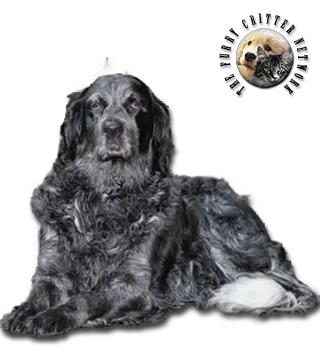Breed Standard
Head: Fairly large. Relatively broad, oval skull. Pronounced stop. Long, fairly broad nosebridge. Wide nose. Flews large, very pendulous.
Ears: Set on slightly above eye level. Fairly thick, framing the head. Covered with silky waves of hair.
Eyes: Large, dark.
Body: Strong. Neck with very slight dewlap allowed. Chest sufficiently deep. Well-arched ribs. Loin not too heavy. Back not too long. Slightly sloping croup
Tail: Not much longer than the hock. Never hooked.
Hair: Flat or slightly wavy. Feathering on the legs and tail.
Coat: Flecked grey or black, creating a bluish cast, with black spots.
Size: Approx. 20 kg (44 lb)..
Weight: Dog: 57 to 60 cm (22.5-23.5 in). Bitch: slightly less
History
At the turn of the 20th century the area around the mouth of the River Somme was considered a paradise for hunters interested in wildfowl. Because of quarantine restrictions in the United Kingdom, British shooters would board their dogs in the Picardy area, near the mouth of the Somme. This caused the infusion of English Setter blood into the local Spaniel population and developed the Blue Picardy Spaniel.
While the first black, blue-grey Spaniel was recorded in 1875, it was not until 1904 when the Picardy Spaniel was first shown. This Spaniel was officially classified as a French Spaniel, and was shown at the Paris Canine Exposition. When the Picard Spaniel and Blue Picardy Spaniel Club was formed in 1907 the two different breeds of Picardy Spaniel were categorised.
In France, the Blue Picardy was recognised as a separate breed in 1938, and there are about 1000 puppies born in France each year. The first person to import the Blue Picardy Spaniel into Canada was Ronald Meunier of Saint-Julien, Quebec, around 1987, and the breed was then recognised by the Canadian Kennel Club effective 1 June 1995. The breed is recognised by the American Rare Breed Association, which uses the same standard as the Federation Cynologique Internationale.
Behavior
It is a versatile hunting dog, used for its ability to locate and retrieve game in harsh and adverse terrain and conditions. It is not specialised to any one type of terrain, and tends to score well in field trials. The Blue Picardy is considered to be a quiet breed, but requires a great deal of exercise as it has a high level of stamina. It loves to play, and is a responsive and obedient breed which thrives on human companionship. It is especially good with children.
He needs space and exercise for his well-being. He does not like being left alone. He requires regular brushing and attention to the ears.
Function
Hunting Dog, Companion Dog.
Health
The breed has no known genetic health issues. Blue Picardy Spaniels can be prone to ear infections, which are common among dogs with pendulous ears.






